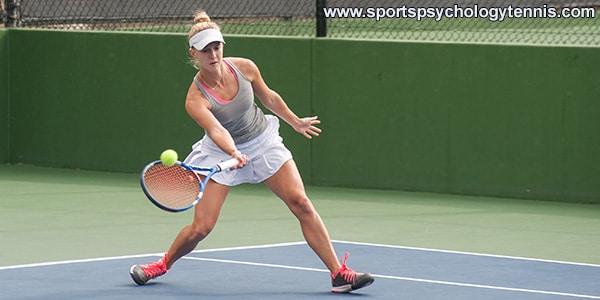
Traditionally, mental imagery has been used by athletes to mentally practice motor skills outside of regular practice. It can also enhance your ability to perform motor skills in competition by improving focus; helping you make plans and develop strategies; and programming your body to execute tennis shots.
Mental imagery and its components (images, thoughts or feelings) are vital to your service routines because they help you to successfully program your body to perform. When you recall the feeling of a good serve for example, you are using mental imagery to help you perform. Not all tennis players, however, correctly apply mental imagery in the service routine.
Many high-level tennis players talk about the term visualization. The problem is that mental imagery or mental rehearsal encompasses more than “visualization” or visual components of imagery. A common misconception is that you must actually “see” pictures in your mind to use mental imagery. Not every athlete is a visual learner and performer.
I have worked with tennis players who have tried to fit into a visual performer perspective, but were more kinesthetically inclined. These players falsely believe that they must “see” pictures in their mind and visualize their strokes or shots. Therefore, they are actually harming their performance and confidence by forcing themselves into a style of mental imagery that might not be suited to their style of visualization and thus, they see change in performance enhancement.
Athletes use a variety of images (visual, feeling, auditory, etc.) to help them get the proper mindset for optimal performance. To make the most of visualization, you will need to tap into the correct pre-service images (based on your style of learning and performing) that will help to program your body for consistent execution and peak performance.
One caution here: too many thoughts or images (or trying too hard) can confuse the mind and limit your performance. Likewise, if you improperly program yourself with the wrong images, performance can suffer.
Most athletes use one of three main types of learning styles. If you learn better via a visual style, for example, then you will most likely want to perform with visual images as well. Visual learners prefer to get information through their visual system. The visual learner absorbs information best by observing a demonstration. In terms of imagery, visual learners like to see pictures in their heads (also called mind’s eye) such as tennis player who pictures the target in his mind’s eye prior to and during the execution of a tennis shot.
Kinesthetic performers learn by experience and want to know how a movement feels. The kinesthetic player must program the body with what the correct movement feels like. The proper feeling of a good serve triggers the serve. For example, a tennis player might feel the tempo of a smooth stroke before the execution of the serve or return of serve. An auditory learner prefers to focus on sounds and rhythms to learn a sports skill. In terms of mental imagery, audiotry athletes perform best when they program their performance with sounds and word cues, such as the sound of making solid contact with the ball.
Do not assume that you must fit into one of the three styles of learning and performing. Most tennis players use a combination of modalities (senses) when they learn, perform, and imagine the execution of tennis shots. For example, a player might see the flight of the serve in his mind and rehearse the feeling of the serve during his service routine.
A simple test you can use to determine your dominant mental images is to hit a few serves in practice. I determine my students’ preferred service imagery by spending time on the court working on a few different service images. The idea here is that you want a positive mental image to occupy the mind and to program the body in a positive way so that you can trust (and remove interference from the conscious mind).
First, I would ask you to hit a few serves in a visual mode by trying to visualize the flight of the ball or focus on the target in your mind’s eye. Second, I would ask you what a good serve feels like. You might say, “Good extension or good balance.” I would have you hit a few serves focusing on balance and full extension. Finally, I would ask you to use a verbal cue to trigger the serve such as tempo. I would have you hit a few serves focusing on a verbal or auditory mechanism to trigger your performance.
The goal is to compare the various service sets you hit to examine (1) the consistency of the serve (location and ball flight) and (2) how effortless each set was to perform. Most often, my students will pick one trigger cue or image that felt easy to do and produced the best results.
Your final thought or image, also called a trigger cue, is the most critical thought in your routine to program your body successfully to perform well. You need to simplify your pre-serve thoughts to only one visual, auditory, or kinesthetic cue. This cue should not be about the “how to” of your performance or about the details of technique. The mind only needs a target or simple image and your hand-eye coordination takes over.